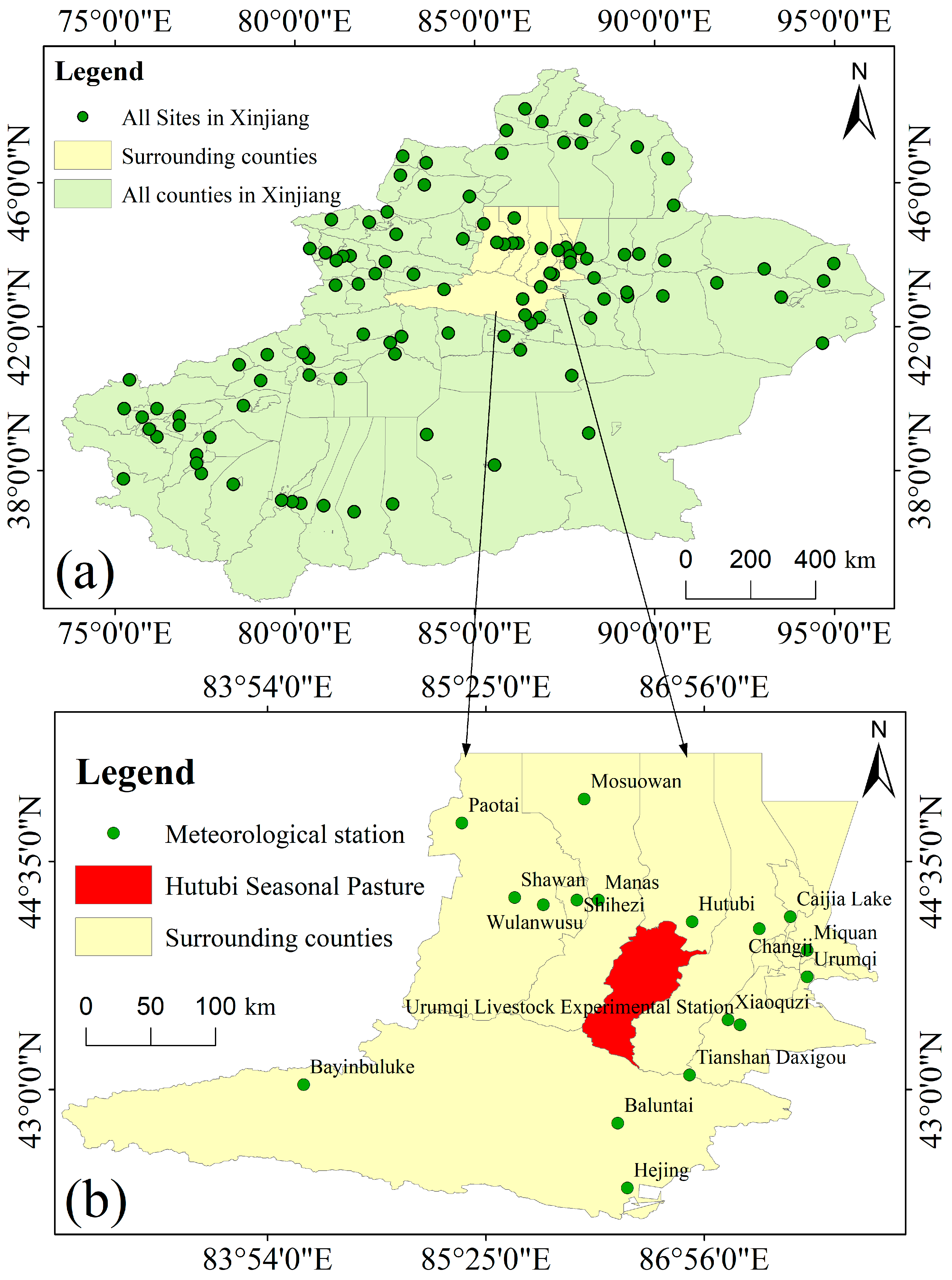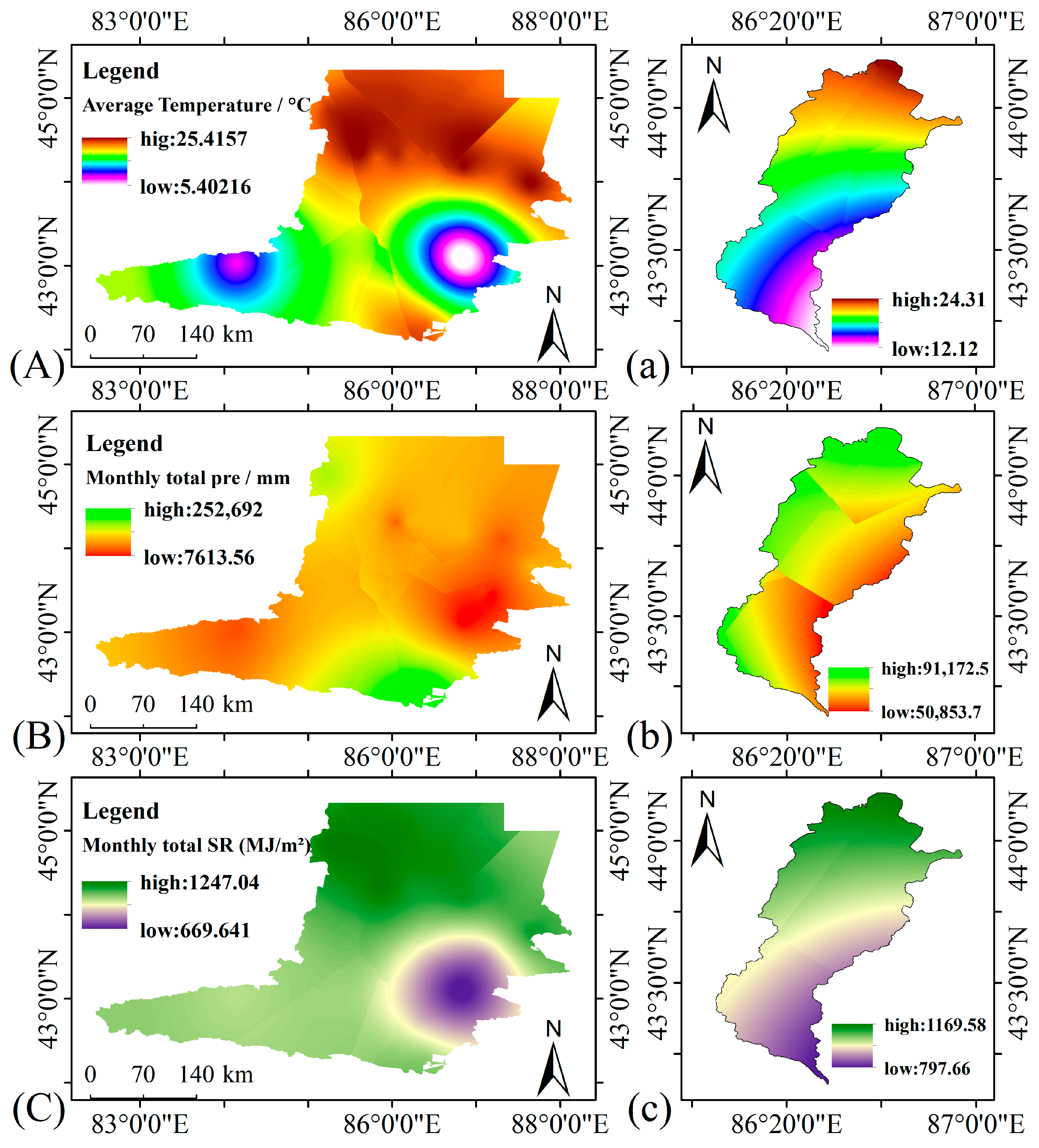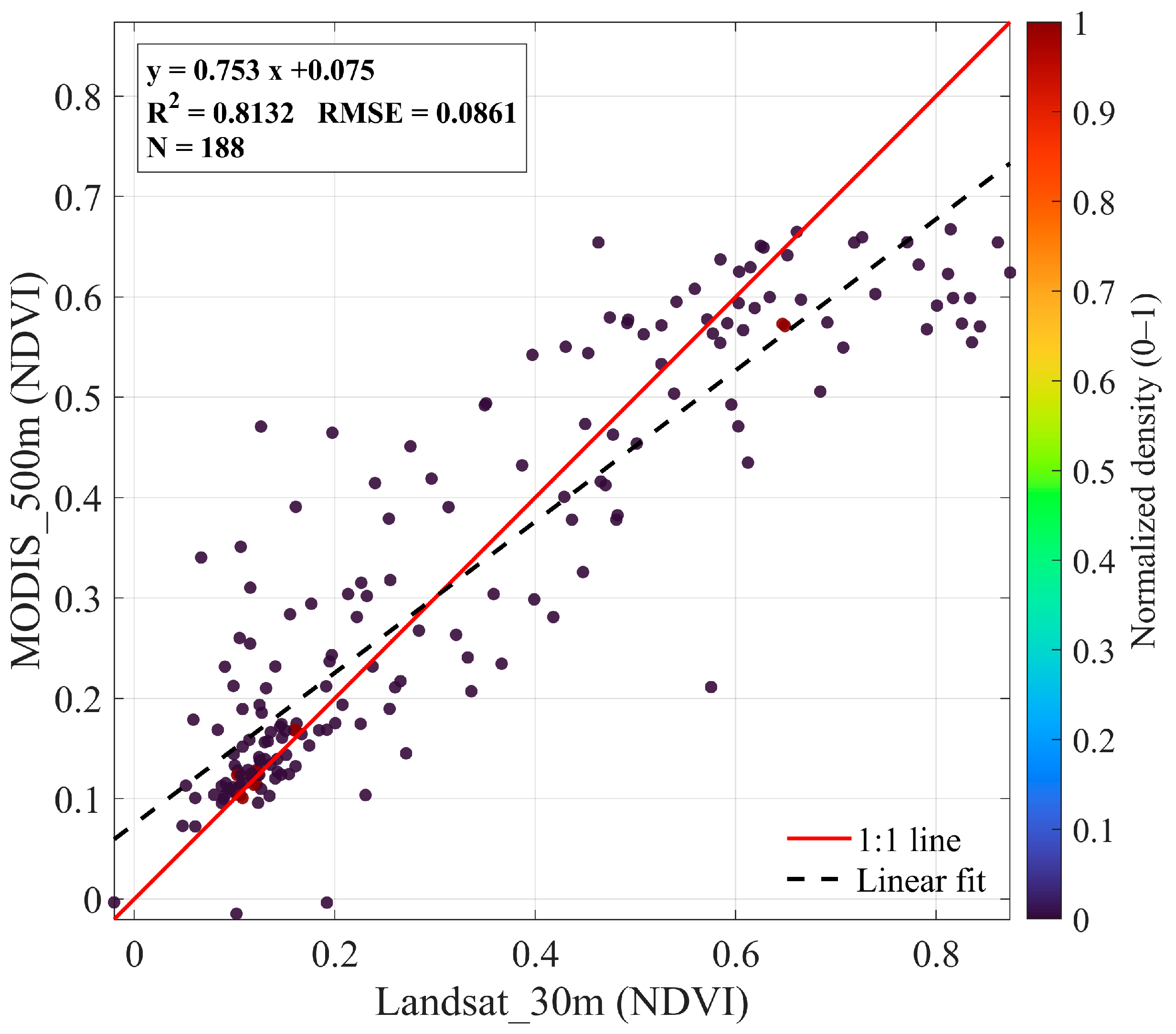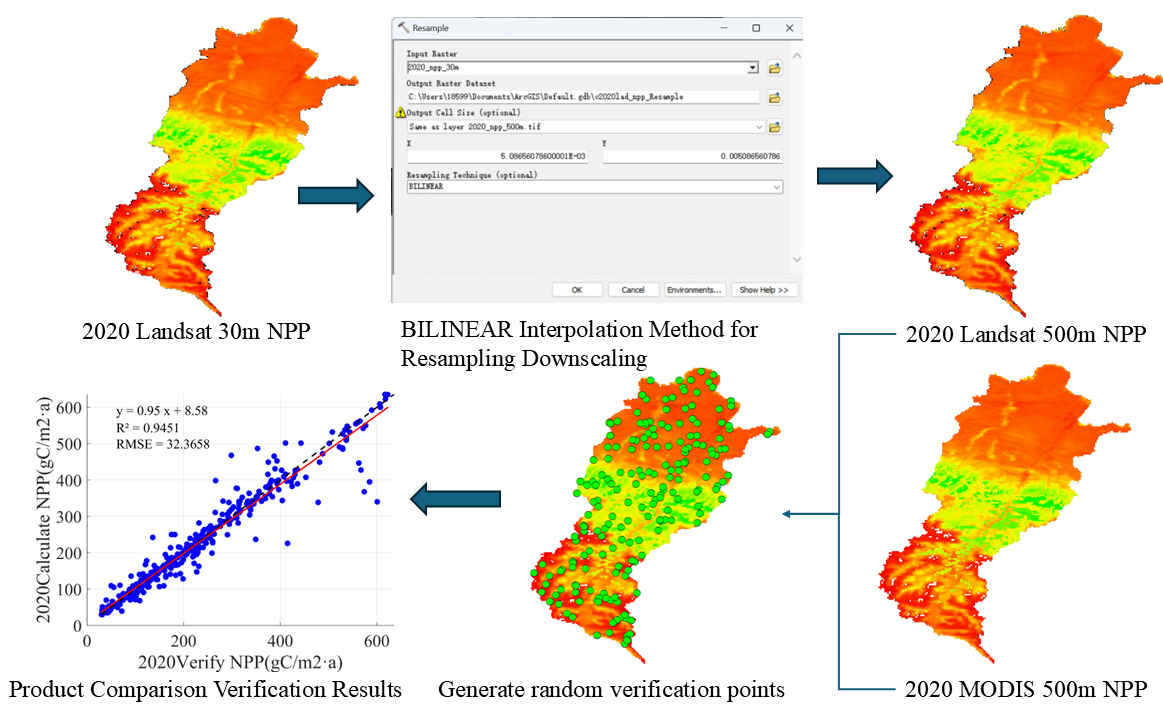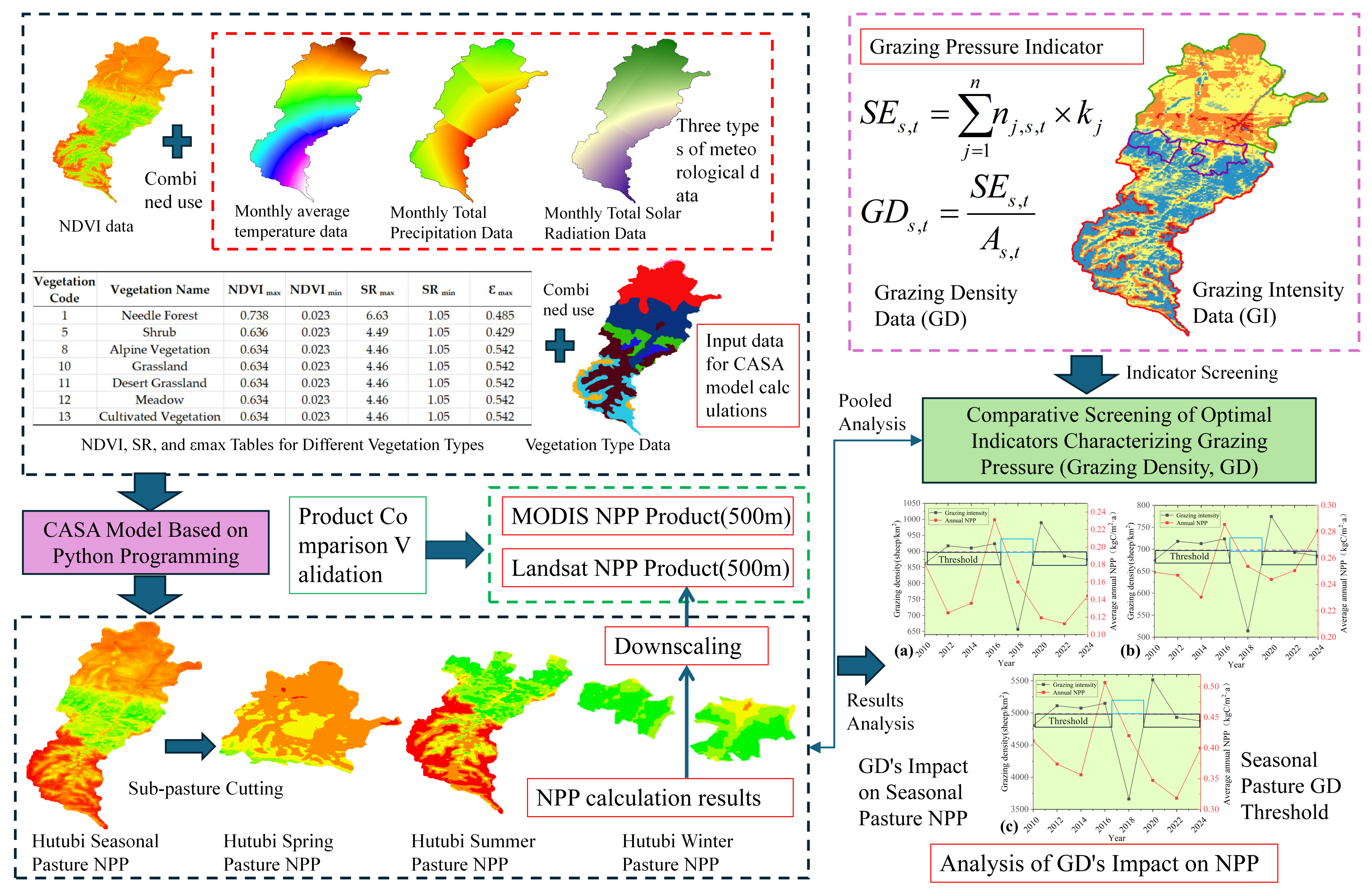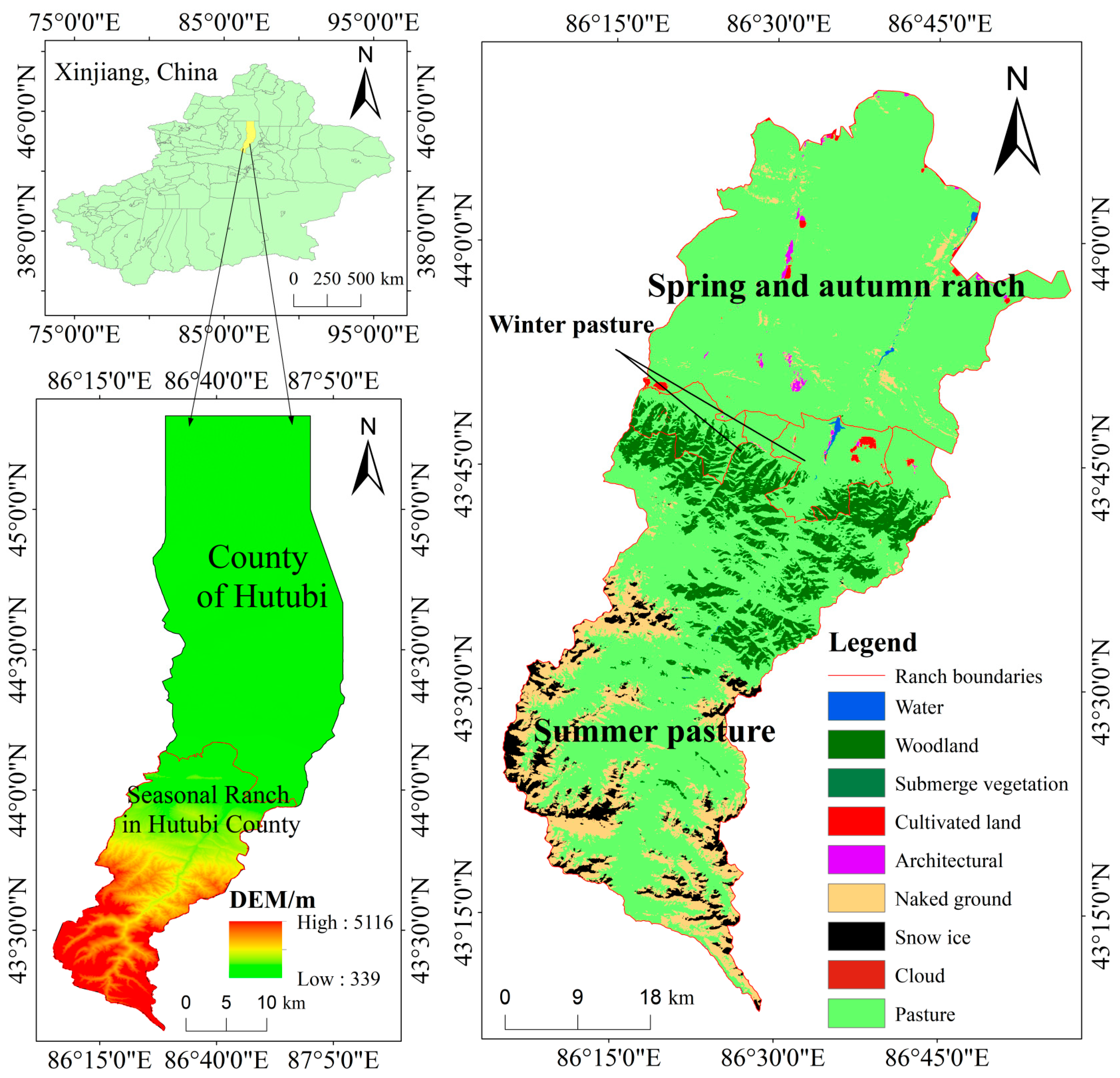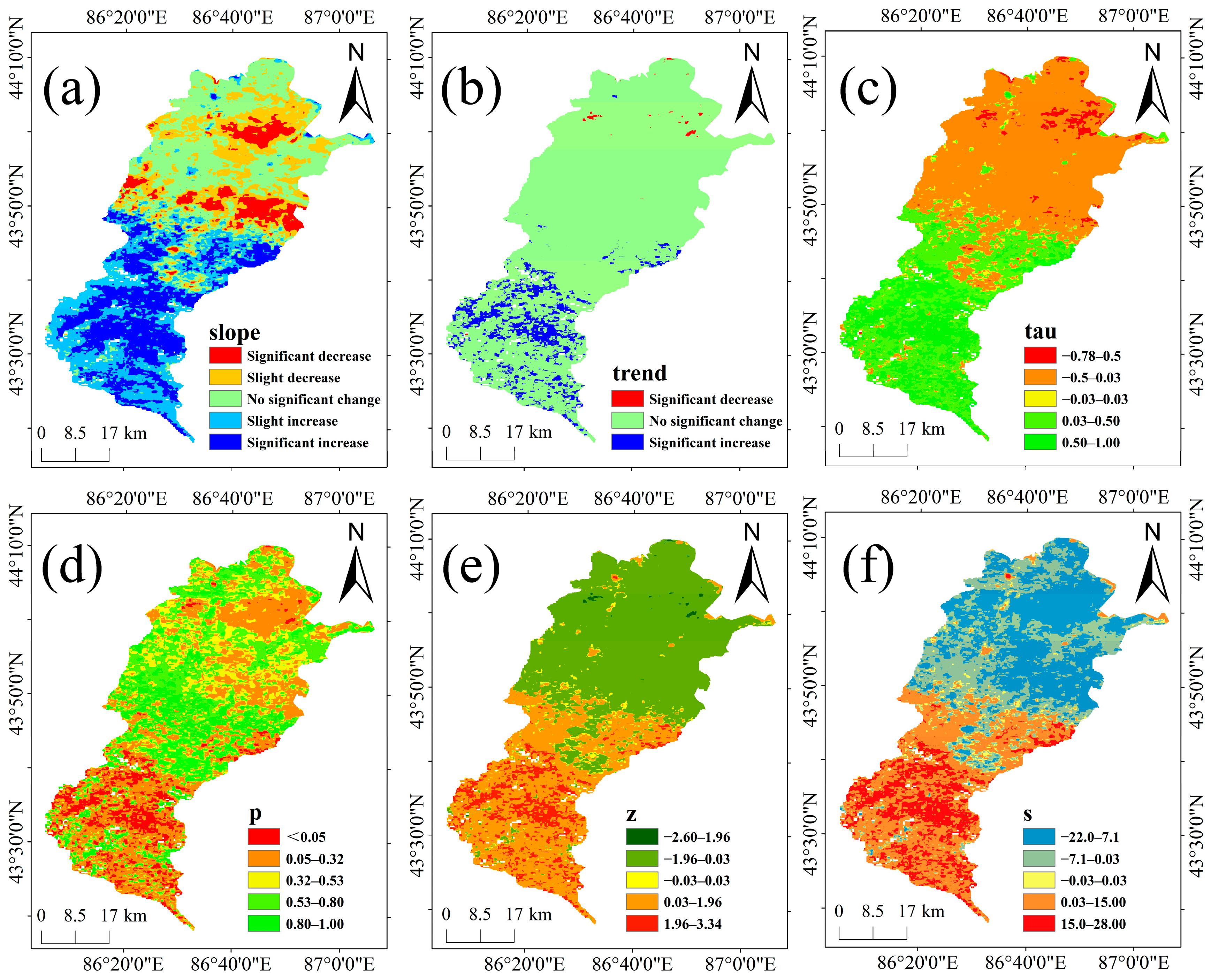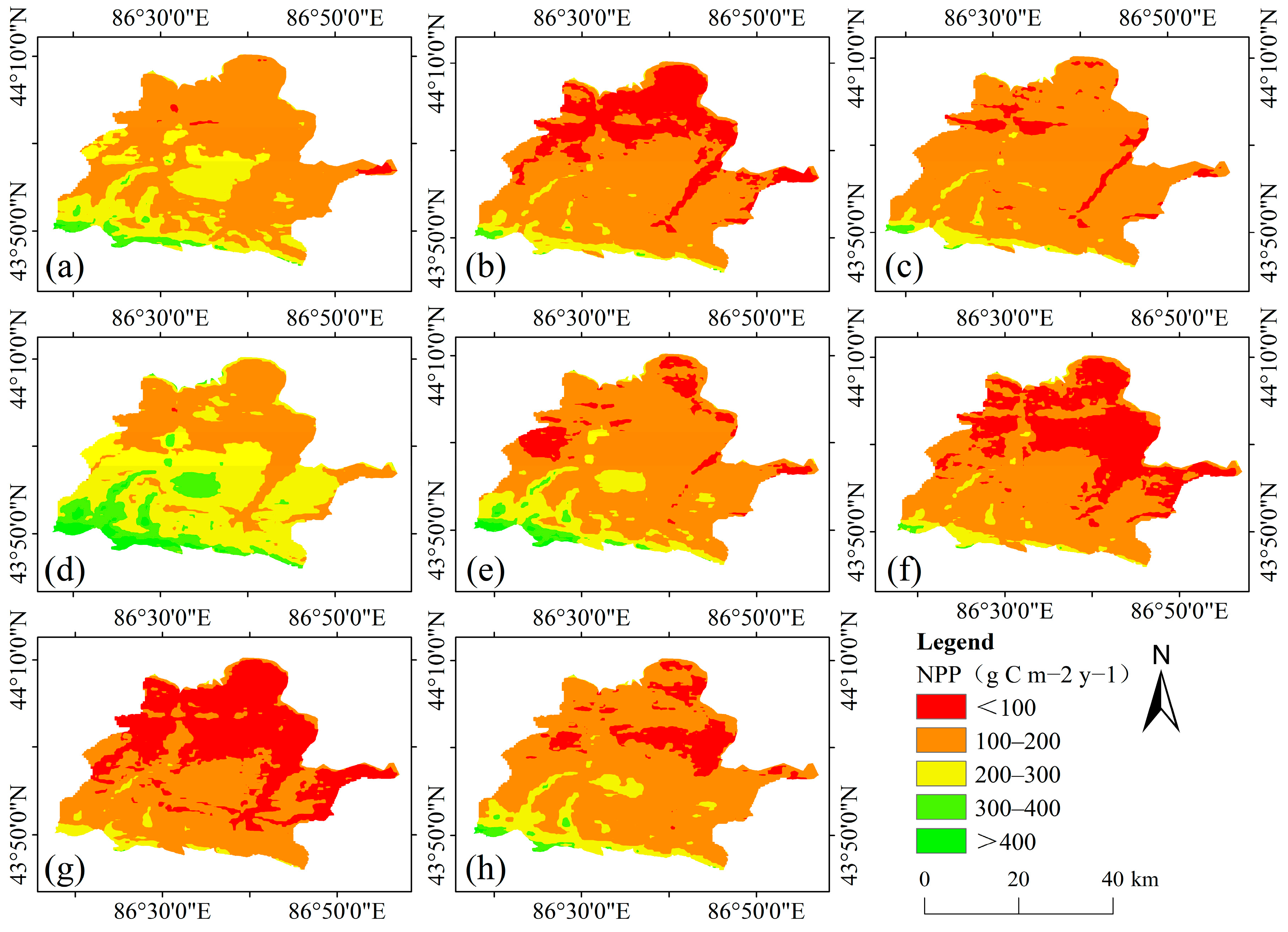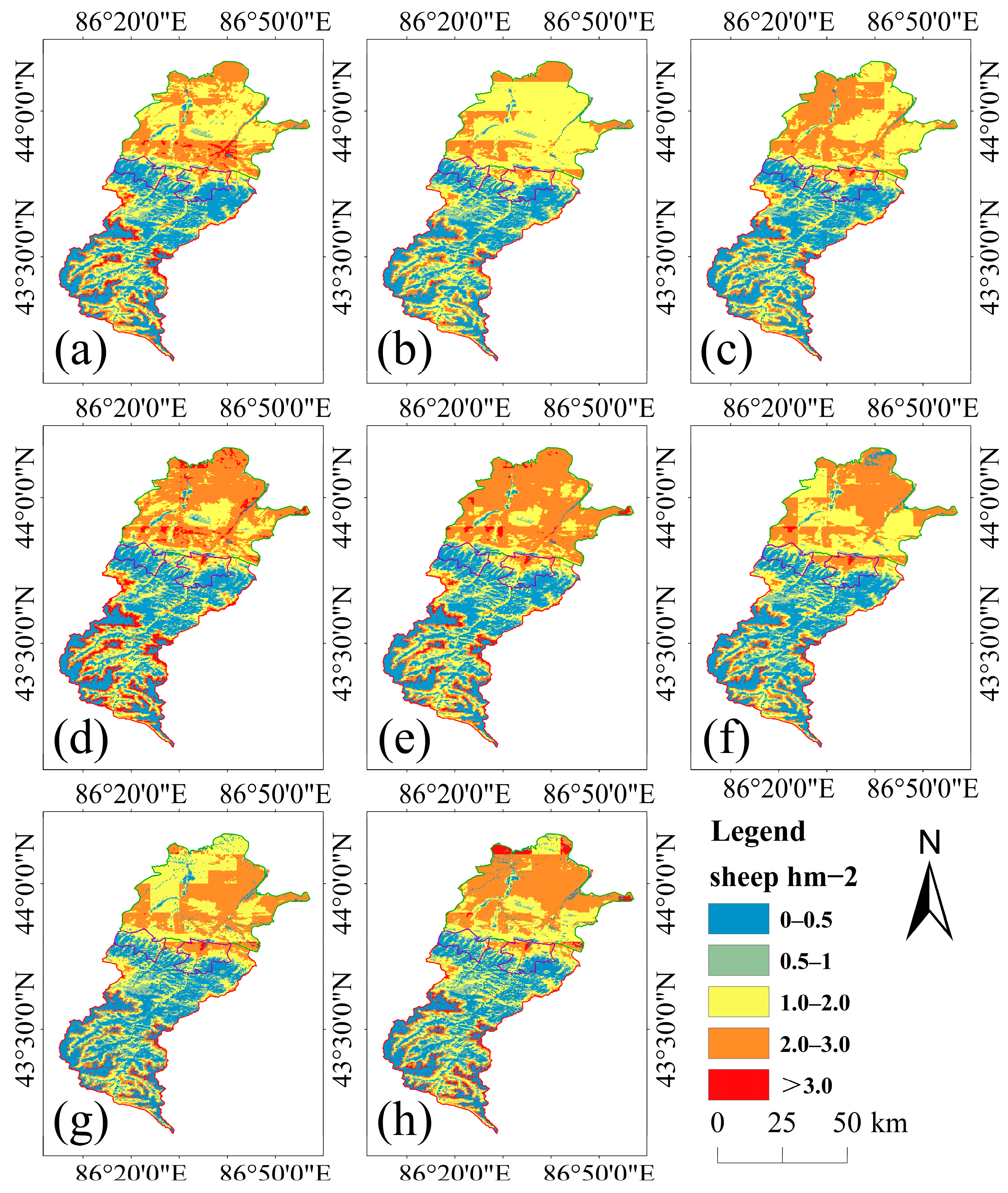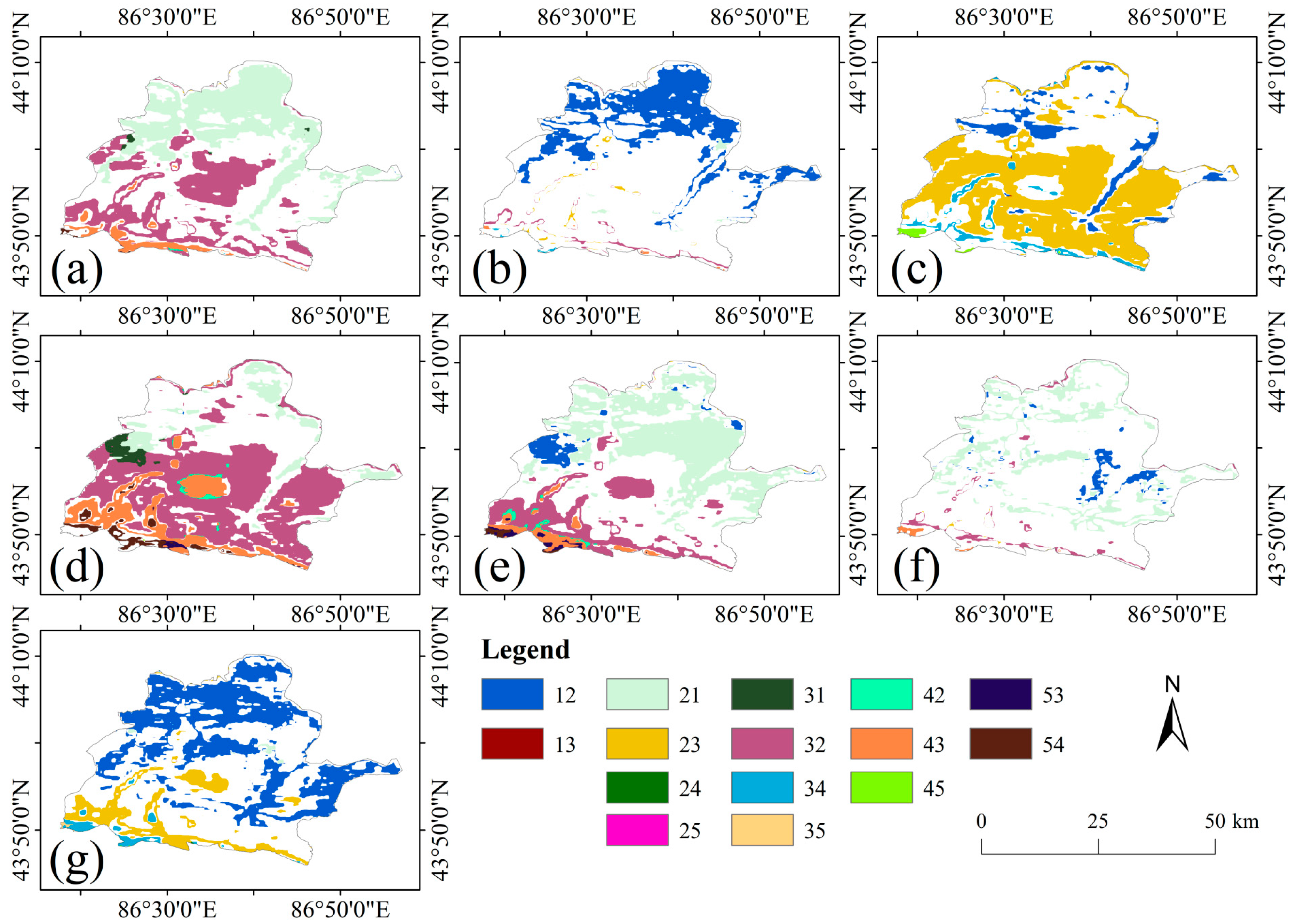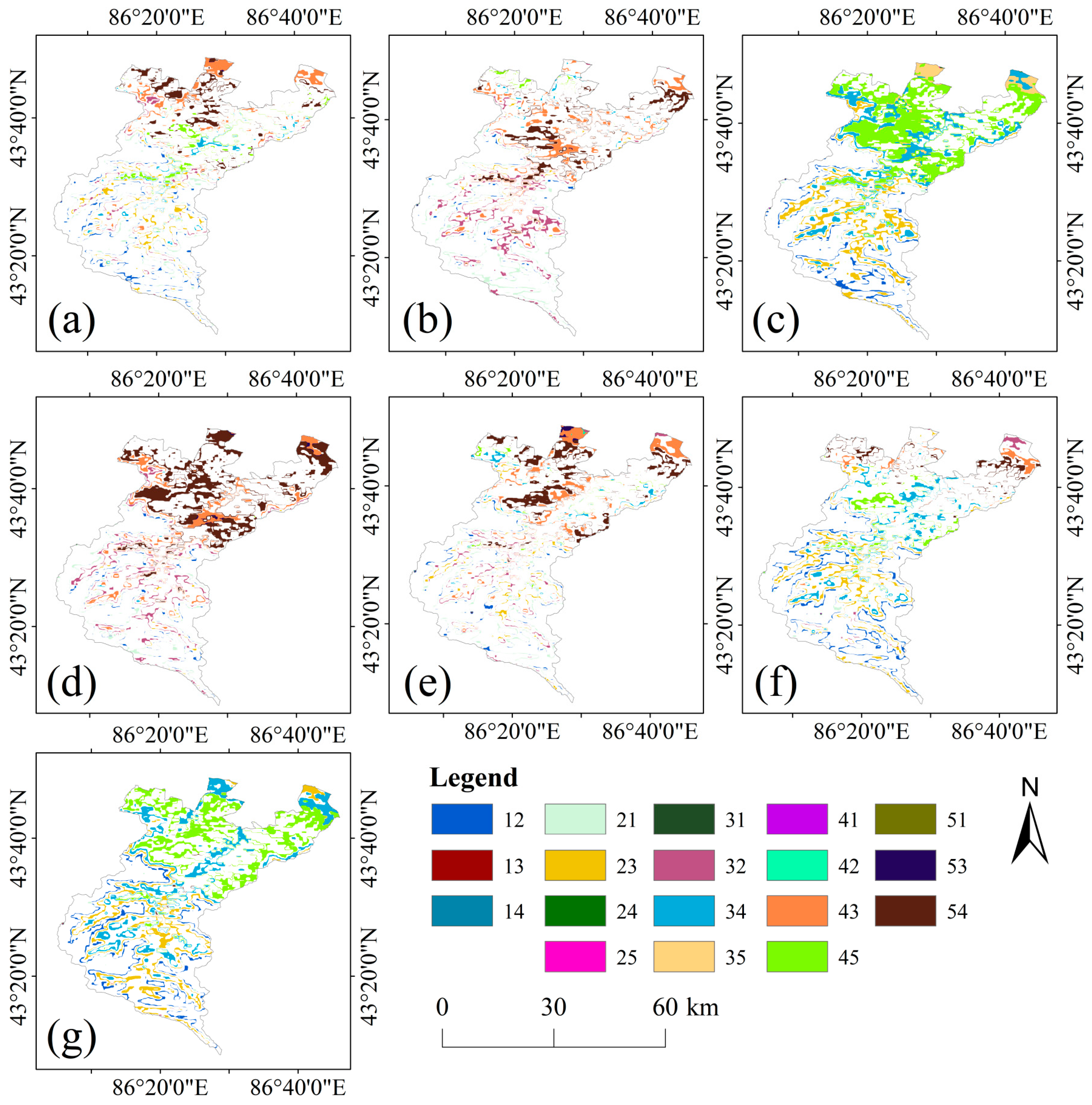1. Introduction
NPP is the organic matter accumulated by plants via photosynthesis after subtracting their autotrophic respiration [
1]. As a key indicator for assessing ecosystem health, NPP not only quantifies the net increase in organic matter accumulated by plants through photosynthesis but also reveals the dynamic equilibrium of grassland carbon storage capacity, nutrient cycling, and biodiversity maintenance [
2]. Currently, with the intensification of factors such as climate variability, soil erosion, and human disturbance, grasslands in many regions face the risk of degradation. Among these factors, human disturbance plays a significant role, primarily manifested as overgrazing. Overgrazing reduces grassland aboveground net primary productivity (ANPP) through livestock consumption and decreases grassland belowground net primary productivity (BNPP) through trampling, thereby diminishing grassland NPP and exacerbating the risk of grassland degradation [
3]. Accordingly, elucidating how GP affects grassland NPP—and the mechanisms involved—is essential for restoring grassland ecosystem services and securing the long-term sustainability of pastoral livestock systems. Moreover, while existing work has largely focused on the effects of GP on soil erosion, plant community traits, and soil physicochemical properties, the specific mechanisms by which GP drives changes in NPP remain underexplored, leaving a critical gap to be addressed [
4,
5,
6].
Grassland NPP estimation can be broadly categorized into non-remote sensing methods and remote sensing methods. Non-remote sensing methods include the following: direct measurement methods [
7], ecosystem process models (e.g., TEM, BIOME-BGC, and CENTURY) [
8,
9,
10], and empirical statistical models (e.g., Miami, Thornthwaite, and Chikugo) [
11,
12,
13]. Although these methods offer high accuracy, they involve significant upfront costs and are limited to small-scale NPP estimation. In contrast, remote sensing methods, driven by satellite observations and meteorological data, enable large-scale spatiotemporal distribution inversion of NPP. Key approaches include light-use efficiency (LUE) models (e.g., CASA, MOD17, GLO-PEM, and VPM) [
14,
15,
16], SIF-constrained methods [
17], and machine learning upsampling (FLUXCOM approach) [
18]. Among these, SIF-constrained methods are sensitive to stress responses but suffer from resolution and inversion uncertainties. Machine learning upscaling methods use tower flux measurements as ground truth, integrating remote sensing and meteorological data to train models capable of generating multi-year global products. However, interpolation analysis may introduce bias in trend interpretations. LUE models, calculated through photosynthetically active radiation (PAR) and photosynthetic efficiency (ε), exhibit robust data requirements and high interpretability. They are most widely applied in arid/semi-arid grasslands, with the CASA model being the most extensively used and well-validated. Current CASA model variants include the standard version [
19,
20], MODIS-driven version [
15], and regionally optimized version [
21]. This study adopts the regionally optimized CASA model as the primary method due to its parameter optimization for China’s arid grasslands and extensive regional-scale validation, making it more suitable for the study area’s characteristics.
GP is a key indicator of the anthropogenic disturbance imposed on grassland ecosystems; in practice, many studies use GI to characterize the GP exerted on a given area over a specified period. It can be defined as the cumulative impact exerted by grazing animals on a pasture over a specified period or, equivalently, as the ratio of herbage removed to herbage available during that period [
22,
23]. Formally, under the NZSAP framework (Occasional Publication No. 10), GI is operationalized as herbage removed relative to herbage availability [
24]. Many scholars have explored how to use GI to represent GP. For example, Wang et al. [
25] combined county-level livestock census data with satellite-derived grassland biomass differences to produce a long-term GI dataset, providing an important reference for identifying the impacts of grazing activities on grassland dynamics. However, such remote-sensing inversion approaches [
26,
27] typically construct GI from vegetation metrics within a given time window (e.g., LAI ratios or NDVI differences; see
Section 3.2). Consequently, GI is strongly collinear with NPP itself [
28], which can obscure the negative feedback of GP on NPP. By contrast, GD—estimated from livestock inventories and pasture area—more faithfully reflects actual GP [
29] (see
Appendix D.6 for the GP–GD–GI schema). Mechanistically, GD captures the negative GP–NPP linkage because GP acts through the light-use efficiency (ε) pathway in productivity models: classic grazing studies show ε is a function of GI (Lemaire et al., 2000, Table 18.7 [
30]). Hence, higher stocking pressure depresses ε—and thus NPP—particularly under moisture- or temperature-limited conditions. This process view also clarifies why climate and policy matter: precipitation/temperature anomalies and rest/rotational-grazing policies jointly modulate ε and realized APAR, reshaping GP’s net effect on NPP. Practically, compared with GI products derived from remote sensing or in situ measurements, a GD-based metric is easier to obtain and process and avoids reliance on vegetation indices. Accordingly, we adopt a GD-grounded GP metric and investigate how GD drives NPP dynamics.
Focusing on the GP–NPP relationship, prior studies have highlighted a negative feedback between GP and NPP, as well as the stimulatory effect of light GP on NPP. For example, Irisarri et al. [
31] found that light increases in GP decreased C
3 grass biomass while increasing C
4 grass biomass. Likewise, Chi et al. [
32] reported a significant negative correlation between NPP residuals and GP. Cui [
33] noted that moderate grazing is conducive to maintaining species diversity and community structure. In addition, Hou [
34] examined the effects of GP on NPP in dry versus wet years and found that NPP follows a quadratic relationship with GP in dry years (peaking under light grazing), but declines linearly in wet years—consistent with the grazing-avoidance hypothesis. However, the above studies treated all pastures within a region as a single unit and averaged the effects of GP on NPP; this overlooks the distinctions among seasonal pastures (spring–autumn, summer, winter) and thus fails to capture season-specific GP–NPP relationships. Accordingly, a key challenge is to efficiently and quantitatively assess how GP—operationalized here as GD—affects NPP across different seasonal pastures, and to systematically compare seasonal differences in NPP responses to GP (e.g., thresholds and shifts in NPP levels). This is a central problem in GP–NPP research and the core focus of the present study.
To investigate how GP influences NPP across seasonal pastures and to characterize associated threshold dynamics—while identifying the most accurate indicator of GP—we proceed as follows. First, we retrieve seasonal-pasture NPP using the CASA model and detect multi-year NPP trends with the Sen’s slope–Mann–Kendall (Sen–MK) approach. Second, by comparing an existing GI product with our GD dataset, we select the indicator that best represents actual GP and, using a transition-matrix analysis, quantify GD-driven shifts in NPP classes across seasons. Finally, we synthesize the threshold ranges and general regularities for different seasonal pastures to provide operational, quantitative guidance for zoned rest grazing, rotational grazing, and intensity regulation in arid and semi-arid regions.
2. Methods
The technical workflow (
Figure 1) comprised four steps: (1) Data acquisition: We collected NDVI; meteorological variables (monthly mean air temperature, monthly total precipitation, and monthly total solar radiation); vegetation type data (both raster and tabular; see
Appendix D.4); and grazing pressure data (GD and GI). (2) Model development: We implemented the CASA light-use efficiency model in Python (version: 3.8.20) to estimate NPP. (3) Model validation: We evaluated model reliability by comparing our NPP estimates against the MODIS NPP product and by conducting trend analyses on the estimated NPP. (4) Result analysis: We analyzed GD-driven spatiotemporal variations in NPP to provide scientific support for grassland management and policy making.
2.1. Study Area
The study area was located in Hutubi County, Changji Hui Autonomous Prefecture, Xinjiang Uygur Autonomous Region, China, at the geographical coordinates 86°05′ E–87°08′ E and 43°07′ N–45°20′ N, and covered a total area of 9721.6 km
2. The study area exhibited a topography that was higher in the south and lower in the north, featuring high mountains and hills along the northern slope of the Tianshan Mountains in the south, alluvial plains in the central region, and desertified Gobi terrain in the north, forming a pronounced topographic gradient. This region was characterized by a typical temperate continental arid–semiarid climate, with an average annual temperature of approximately 6.7 °C, average annual precipitation of about 167 mm, and average annual sunshine duration of roughly 3090 h. These climatic conditions shaped a distinctive ecological landscape. Hutubi County had abundant vegetation resources, which mainly consisted of grasslands, meadows, alpine vegetation, and cultivated vegetation. Its pasture resources were particularly prominent, including multiple seasonal pastures such as the South Mountain pasture, Que’ergou Town pasture, and Yuanhu Village Town pasture. These pastures were categorized by grazing period into spring, summer, and winter pastures. The winter pasture was further subdivided into two spatially separate units, a left pasture and a right pasture. These pastures exhibited distinct seasonal variations in both time and space, providing an ideal setting for examining the dynamic effects of GP on NPP. An overview of the study area is shown in
Figure 2.
2.2. Data Acquisition
2.2.1. Data Types and Sources
Estimating NPP using the CASA model required preparing multiple data types. These included NDVI data, vector data, meteorological data, and vegetation type data. Additionally, GP data and NPP product validation data were prepared. The specific data types and sources are detailed in
Table 1.
2.2.2. Data Preprocessing
Before calculating NPP, we standardized all input datasets. (1) NDVI data: We computed NDVI for eight time periods between 2010 and 2024 using the GEE platform. When compositing NDVI, we used images from July–August to generate mean composites, because this approach could improve the quality of the NDVI estimates. (2) Vector data: These data were mainly used to clip the study area and included the overall seasonal pasture polygon as well as three internal seasonal pasture polygons (spring–autumn pasture, summer pasture, and winter pasture). (3) Meteorological data: We used daily August data for eight time periods between 2010 and 2024, obtained from the Daily Dataset of Basic Meteorological Elements at National Ground Meteorological Stations in China (V3.0). Point vector data for 17 meteorological stations surrounding the study area were generated and then converted to raster data using ordinary kriging interpolation, with a spatial resolution of 30 m (the detailed workflow was provided in
Appendix D.1 and
Appendix D.3). (4) Vegetation type data: We obtained a vegetation type map for the study area and converted the vector data to raster format to generate a vegetation type raster with a spatial resolution of 30 m (see
Appendix D.4 for details). (5) Maximum light-use efficiency data: From the relevant literature, we obtained the maximum and minimum NDVI and SR values, as well as the maximum light-use efficiency (
εmax), for seven vegetation types in the study area. By matching these to the codes of each vegetation type, we produced a table of maximum light-use efficiency values to support the NPP calculations (see
Appendix D.4,
Table A2). (6) Grazing intensity data: We obtained raster datasets for eight time periods from 2010 to 2024 from an open dataset and clipped them to derive grazing-intensity maps for the study area. Based on these rasters, we calculated the annual mean GI for each of the eight time periods (the specific calculation formula was given in
Section 3.2). (7) Grazing density data: Following the standard sheep unit conversion rules for livestock on the northern slope of the Tianshan Mountains [
35] (
Appendix A,
Table A1), different types of livestock were converted to a unified sheep unit, and the total converted livestock numbers were summarized (
Appendix A,
Table A2). The annually converted livestock totals were then divided by the area of each seasonal pasture to obtain GD data for each seasonal pasture in Hutubi County from 2010 to 2024 (
Appendix A,
Table A3). (8) Validation data: We obtained MODIS NPP products with a spatial resolution of 500 m for eight time periods between 2010 and 2024 from an open dataset. These NPP products were clipped to the study area and used for product-based validation. The scale-matching between modeled NPP (30 m) and product NPP (500 m), as well as the validation procedure, was shown in
Appendix D.5,
Figure A8.
2.3. CASA Model
In this study, we used the CASA model, an ecosystem process model based on the principle of photosynthetic energy utilization. This model required inputs from remote-sensing data, air temperature, precipitation, solar radiation, and vegetation type data. We implemented the CASA model at a yearly time step in August (
t), because that month corresponded to the peak vegetation growth season in the study area. Thus, the calculated NPP represented the monthly NPP for August, reflecting the maximum photosynthetic activity of each year rather than the annual total NPP. This time-step adjustment was appropriate for arid–semiarid grasslands, where vegetation growth and photosynthesis were strongly concentrated within a short growing season (typically July–August). Meteorological and radiation inputs (temperature, precipitation, and total solar radiation) were also extracted for August to maintain temporal consistency with the NDVI data. Using Equation (1), we estimated NPP from absorbed photosynthetically active radiation (
APAR) and the photosynthetic energy conversion efficiency (
ε), following the approach of Hadian et al. [
36]:
where
x represents any pixel in the image.
NPP(
x,
t) denotes the NPP of pixel
x at time
t (g C m
−2 y
−1).
APAR(
x,
t) denotes the
APAR of pixel
x at time t (MJ m
−2 y
−1).
ε(
x,
t) denotes the
ε of pixel
x at time
t (g C MJ
−1).
2.3.1. APAR Calculation
APAR served as the driving force for plant photosynthesis, showing a high correlation with plant biomass. It was also a key factor in the CASA model’s calculation of vegetation NPP, with its calculation given in Equation (2):
where
SOL(
x,
t) denotes the total solar radiation at pixel
x and time
t (MJ m
−2 month
−1).
FPAR(
x,
t) denotes the fraction of photosynthetically active radiation absorbed by vegetation at pixel
x and time
t (dimensionless). The constant 0.5 indicates the ratio of effective solar radiation (0.38–0.71 μm) available for vegetation utilization. For
SOL(
x,
t), when radiation data were unavailable, we derived it from sunshine duration. For
FPAR(
x,
t), it can, in principle, be estimated from either the normalized difference vegetation index (NDVI) or the simple ratio vegetation index (SR) [
37]. In practice, NDVI is typically used to derive FPAR in areas with moderate to high vegetation cover, whereas SR is more sensitive to reflectance changes under sparse vegetation and is therefore more suitable for estimating FPAR in low-cover environments. In this study, because the seasonal pastures in the study area generally had relatively high vegetation cover, we calculated
FPAR(
x,
t) solely from NDVI, as given in Equations (3) and (4). For applications in sparsely vegetated areas, the SR-based FPAR formulation can still be found in Sun et al. [
37]:
where
NDVImax,
NDVImin represent the maximum and minimum values of NDVI for different vegetation types, respectively.
FPARmax and
FPARmin denote the maximum and minimum values of
FPAR for different vegetation types, respectively, and these two constants were set to 0.950 and 0.001, respectively [
38].
NDVI(
x,
t) denotes the NDVI of pixel
x at time
t (dimensionless).
NIR denotes the near-infrared band of the remote-sensing image, while
R denotes the red band of the remote-sensing image.
2.3.2. ε Calculation
Actual light energy utilization efficiency (
ε) refers to the ratio between the chemical energy contained in the dry matter produced by vegetation photosynthesis per unit area and time and the incident photosynthetically active radiation per unit area and time [
39]. The formula for
ε(
x,
t) is given in Equation (5):
where
Tε1(
x,
t) and
Tε2(
x,
t) are dimensionless temperature-stress coefficients that describe the effects of low and high temperature, respectively, on vegetation photosynthetic efficiency.
Wε(
x,
t) is a dimensionless water-stress coefficient that reflects the effect of water availability on photosynthetic efficiency.
εmax denotes the maximum light-use efficiency for each vegetation type (g C MJ
−1). The values of
εmax for each vegetation type were obtained from the relevant literature.
The two temperature-stress coefficients,
Tε1(
x,
t) and
Tε2(
x,
t), are key variables for determining the actual light-use efficiency, and their calculation is given in Equations (6) and (7):
where
T(
x,
t) denotes the average air temperature of the pixel during the time period.
Topt(
x,
t) denotes the optimal temperature for the growth of each vegetation type, which was estimated from the mean August temperature.
In this study, the water-stress coefficient ranged from 0.5 to 1.0, with values closer to 0.5 in drier areas and closer to 1.0 in wetter areas. Its calculation is given in Equation (8):
where
E(
x,
t) represents the actual evapotranspiration (mm) and
Ep(
x,
t) represents the potential evapotranspiration (mm).
2.3.3. Determination of Vegetation Static Parameters
The vegetation static-parameter file was used primarily to run the NPP computation module. It contains five components: vegetation code (Vege-code), the maximum and minimum of NDVI, the maximum and minimum of SR, and the maximum light-use efficiency (ε
max), which were obtained from the literature [
40]. Using the 1:1,000,000 vegetation map, we identified seven vegetation types within the study area; the static parameters for each type are provided in
Appendix D.4,
Table A2.
2.4. GD Calculation
In this study, we employed GD to quantify GP, rather than the process-based “GI” defined within the NZSAP framework as the ratio of forage removal to available forage. GD represented the standardized number of livestock per unit area over a statistical period (year). It served as a stable proxy for GP at the regional scale, reflecting the spatial utilization intensity of grazing activities rather than the instantaneous proportion of forage removed.
To ensure comparability across different livestock types, the number of each livestock category was first converted into standard sheep equivalents using the standard sheep conversion factor commonly applied in the northern Tianshan region (see
Appendix A Table A1). The total standardized livestock number
SEs,t for each pasture during season s in year t was then calculated using the following formula:
where
SEs,t denotes the standardized total livestock count (head, converted to standard sheep equivalents) for seasonal pasture
s in year
t.
nj,s,t represents the number of livestock of category
j (head) in seasonal pasture s during year
t.
kj is the standard sheep equivalent conversion coefficient (dimensionless) for livestock category
j.
As,t represents the effective grazing area (km
2) of seasonal pasture s in year
t;
GDs,t denotes the GD (sheep km
−2).
It should be noted that this study employed GD rather than process-based GI as a measure of GP. GI refers to the proportion of forage consumed relative to available forage within a unit time period, representing a process variable; GD denotes the standardized number of livestock per unit area, functioning as a spatial pressure variable. Due to the scarcity of high-resolution spatiotemporal data on forage production, consumption, and regeneration at the regional scale, it is difficult to obtain reliable estimates of GI. In contrast, GD is based on statistical livestock counts and grazing area, offering high data availability and strong repeatability, thereby enabling stable characterization of gradients in grazing utilization. Furthermore, GD and GI typically exhibit high interannual and spatial correlation, making GD a suitable observable proxy to reflect the negative feedback effect of GP on NPP. Therefore, this study employed GD as the key grazing indicator for threshold and NPP response analyses.
2.5. GI Calculation
In this study, we used the annual GI dataset developed by Wang et al. [
25]. This dataset integrated climate-driven grassland productivity with satellite-remote-sensing biomass estimates, accounting for discrepancies between livestock numbers and available forage quantities. We employed this dataset for comparative analysis with the GD data collected in this study to assess which metric more accurately characterized GP. The core formula for calculating GI, used to estimate GI across counties and districts in the study area, is given below.
where, in Equations (11)–(14),
TSUP j denotes the total potential livestock carrying capacity of county
j;
SUP i represents the potential livestock carrying capacity of pixel
i (unit: standard sheep units, SU);
AgbliveP i indicates the available grassland biomass of that pixel (g C);
Agblives represents the biomass consumed by one standard sheep per year;
Agblivec i denotes the baseline aboveground biomass of the pixel (g C);
Gr represents the grassland regeneration rate;
Ur indicates the grassland utilization rate;
SHf is the standard hay conversion factor;
S is the daily hay ration per standard sheep (1.8 kg·SU
−1·day
−1);
Wr denotes the standard hay moisture content (14%);
Cf is the biomass-to-carbon conversion factor (0.45 g C·g
−1);
D is the annual grazing days (365 days). In Equations (15)–(17),
SUpas j denotes the baseline livestock carrying capacity of grassland in county
j;
SUcen j represents the livestock census data for county
j;
SUcro j indicates the crop-based livestock carrying capacity for county
j.
SUpas i denotes the grassland-based carrying capacity of county
i;
Diffi represents the difference between climate-based and satellite-based biomass for pixel
i; n is the number of grassland pixels in county
j. The specific parameters and computational details are described in detail in Wang et al. [
25].
2.6. Spatial Analysis (Graph Analysis Method)
Map analysis is a commonly used method for analyzing changes in land use types [
41], with its calculation given by Equation (18).
where M represents the NPP conversion code for a given period, A denotes the NPP class of the preceding year, and B denotes the NPP class of the subsequent year. Equation (8) was used to calculate the NPP class change for each pixel between the two periods (e.g., 21 indicates a conversion from class 2 NPP in 2010 to class 1 NPP in 2012). In this study, to facilitate the analysis of seasonal pasture NPP class changes, all annual NPP values were categorized into five classes based on NPP levels: below 100 g C m
−2 y
−1, 100–200 g C m
−2 y
−1, 200–300 g C m
−2 y
−1, 300–400 g C m
−2 y
−1, and >400 g C m
−2 y
−1. Higher classes indicated higher NPP values.
2.7. SEN-MK Trend Test
SEN-MK is a method for detecting trend changes in long-term time series data and performing significance tests on these changes. It comprises two components: Theil–Sen slope and Mann–Kendall trend. The Theil–Sen slope method, also known as Sen slope estimation, is a robust nonparametric statistical approach for trend calculation. This method offers high computational efficiency, is insensitive to measurement errors and outliers, and is suitable for trend analysis in long-term time series data [
42]. In this study, the calculation formulas are given in Equations (19) and (20):
where
slopei,j denotes the slope value between paired observations
i and
j, representing the rate of change in observed values from time point
i to time point
j.
yj denotes the observed value at time point
j;
yi denotes the observed value at time point
i.
i denotes an earlier index in the data sequence (ranging from 1 to n − 1), and
j denotes the later index in the data sequence (ranging from i + 1 to n). In this formulation,
β represents the estimated Theil–Sen slope, reflecting the overall rate of change trend across the entire time series, and Median { } denotes the median operator. If
β > 0, this indicates an increasing trend in vegetation cover, whereas
β < 0 indicates a decreasing trend in vegetation cover.
The Mann–Kendall trend test is a nonparametric method for assessing the significance of monotonic trends in time-series data. In this study, we summarized its outputs in five indicators. (1) Trend index: Based on the MK test results, we classified trends as increasing (1), decreasing (−1), or no trend (0). This index represented the MK test’s determination of trend direction; classification depended on the sign of Z and the p-value, without an explicit closed-form formula. Specifically, we used the following rules: if Z > 0 and p < α (e.g., 0.05), then “increasing” (1); if Z < 0 and p < α, then “decreasing” (−1); otherwise, “no trend” (0). (2) p-value: p was the significance indicator for the MK test, used to determine whether the trend was statistically significant (e.g., p < 0.05). (3) S-value: S was the Mann–Kendall score, reflecting the strength and direction of the trend. It was the fundamental statistic of the MK test; a positive S indicated an overall upward trend, a negative S indicated a downward trend, and a value close to 0 indicated no trend. (4) Tau value: τ (Kendall’s tau) was a standardized correlation coefficient associated with the MK test that quantified monotonic trend strength; τ > 0 indicated a positive (ascending) trend, τ < 0 indicated a negative trend, and values close to 0 indicated no monotonic trend. (5) Z-value: Z was the standardized test statistic serving as the significance measure for the MK test. It was calculated from S and its variance and was used to approximate the normal distribution. A positive Z indicated an upward trend, a negative Z indicated a downward trend, and |Z| > 1.96 (corresponding to p < 0.05 for a two-tailed test) indicated a statistically significant trend.
2.8. Performance Metrics (Accuracy Evaluation)
In this study, we evaluated model accuracy using a product-based validation approach, with
RMSE and
R2 selected as the performance metrics. The corresponding formulas are given in Equations (21) and (22):
where
RMSE denotes the root mean square error, which shares the same units as the observed value
Yi and ranges from 0 to +∞.
n represents the total sample size (the length of the time series or dataset).
Yi denotes the observed value for the i-th sample (e.g., the true NPP value), and
yi denotes the model-predicted value for the i-th sample.
R2 denotes the coefficient of determination, which is dimensionless and typically ranges from −∞ to 1.
Ymean denotes the arithmetic mean of all observed values
Yi.

